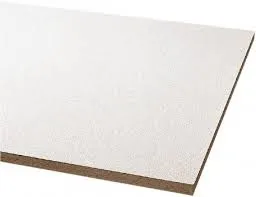- Afrikaans
- Albanian
- Amharic
- Arabic
- Armenian
- Azerbaijani
- Basque
- Belarusian
- Bengali
- Bosnian
- Bulgarian
- Catalan
- Cebuano
- Corsican
- Croatian
- Czech
- Danish
- Dutch
- English
- Esperanto
- Estonian
- French
- German
- Greek
- Hindi
- Indonesian
- irish
- Italian
- Japanese
- Korean
- Lao
- Malay
- Myanmar
- Norwegian
- Norwegian
- Polish
- Portuguese
- Romanian
- Russian
- Serbian
- Spanish
- Swedish
- Thai
- Turkish
- Ukrainian
- Uzbek
- Vietnamese
Oct . 21, 2024 06:45 Back to list
Composition and Materials Used in Mineral Fiber Ceiling Tiles Explained
What Are Mineral Fiber Ceiling Tiles Made Of?
Mineral fiber ceiling tiles are a popular choice in commercial and residential construction, known for their excellent acoustic properties, affordability, and ease of installation. But what exactly are these tiles made of? Understanding the composition of mineral fiber ceiling tiles provides insights into their functionality and benefits in various settings.
Composition of Mineral Fiber Ceiling Tiles
Mineral fiber ceiling tiles are primarily made from a combination of natural and synthetic materials. The main constituents include
1. Mineral Wool This is one of the primary ingredients of mineral fiber ceiling tiles. Mineral wool is made from volcanic rock or industrial by-products like slag and is spun into fine fibers. This material is prized for its sound absorption properties and fire resistance, making it a key component in achieving a quiet and safe environment.
2. Gypsum Gypsum is another crucial material often used in the production of mineral fiber ceiling tiles. Known for its fire-resistant properties, gypsum helps in enhancing the fire safety of the ceiling system. Additionally, it contributes to the tile's overall strength and durability.
3. Cellulose Fiber Many mineral fiber products incorporate cellulose, which is derived from recycled paper products. This addition not only helps with sound absorption but also makes the tiles more environmentally friendly, aligning with the growing demand for sustainable building materials.
4. Binders To give mineral fiber ceiling tiles their form, various binders are used, typically in the form of starch or synthetic resins. These binders hold the mineral fibers together, ensuring the tiles maintain their shape and integrity over time. The choice of binder can affect the tile's performance, including its moisture resistance and dimensional stability.
5. Additives Depending on the specific application and desired properties, manufacturers may include additional additives. These can enhance characteristics such as mildew resistance, color, and texture, providing variety and customization options for architects and designers.
The Manufacturing Process
The production of mineral fiber ceiling tiles involves several steps that transform raw materials into finished products. The process typically includes
1. Fiber Creation Raw materials, such as rock and recycled cellulose, are heated and blended into a slurry. This mixture is then processed to create fibers that are fine and uniform in size.
2. Mixing The mineral fibers are then mixed with binders and additives, ensuring even distribution throughout the batch. This mixture is crucial for achieving the desired properties in the final product.
what are mineral fiber ceiling tiles made of

3. Forming The fiber mixture is pressed into sheets or tiles under controlled conditions. This step is essential for defining the tile's thickness, density, and surface texture.
4. Curing The formed tiles are cured through a heat treatment process, which solidifies the binder and sets the structure of the tiles. This step also helps eliminate any moisture content that could affect performance.
5. Finishing Once cured, the tiles may undergo additional finishing processes, such as coating or texturing, to enhance aesthetics and surface performance.
Benefits of Mineral Fiber Ceiling Tiles
The composition and manufacturing process of mineral fiber ceiling tiles contribute to a range of benefits that make them a popular choice in various applications
- Acoustic Performance The porous nature of mineral fibers allows for effective sound absorption, reducing noise levels in busy environments like offices and schools.
- Fire Resistance With the inclusion of mineral wool and gypsum, these tiles exhibit excellent fire resistance, helping to improve safety in case of emergencies.
- Energy Efficiency Mineral fiber ceiling tiles can aid in thermal insulation, contributing to energy conservation by maintaining desired temperatures in indoor spaces.
- Sustainability Many products on the market are made with environmentally friendly materials, including recycled content, making them a preferred choice for green building initiatives.
- Aesthetic Versatility Available in various textures and colors, mineral fiber tiles can complement a wide range of design objectives, providing endless possibilities for architects and designers.
Conclusion
In conclusion, mineral fiber ceiling tiles are composed of a blend of mineral wool, gypsum, cellulose fibers, and binders, all carefully processed to create a versatile and effective building material. Their beneficial properties, including acoustic performance, fire resistance, and sustainability, make them suitable for numerous applications in both commercial and residential settings. Understanding the materials and processes involved in their production can help consumers and professionals make informed decisions when selecting building materials for their projects.
-
Transform Interiors with PVC Gypsum Ceiling: A Stylish, Durable, and Moisture-Resistant SolutionNewsMay.19,2025
-
The Smart Interior Upgrade: Discover the Durability and Versatility of Gypsum Ceiling Access Panel SolutionsNewsMay.19,2025
-
The Smart Choice for Interior Design: Discover the Value of PVC Gypsum Ceiling SolutionsNewsMay.19,2025
-
Mineral Fiber Ceiling Tiles: The Smart Blend of Performance and AestheticsNewsMay.19,2025
-
Mineral Fiber Ceiling Tiles: The Superior Choice Over Gypsum for Sound and Fire SafetyNewsMay.19,2025
-
Mineral Fiber Ceiling Tiles: Eco-Friendly Strength and Style for Every CeilingNewsMay.19,2025







